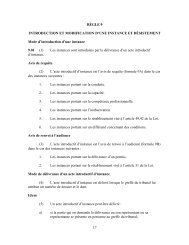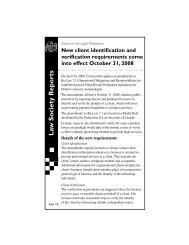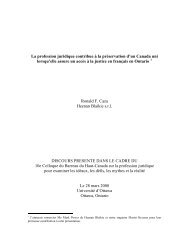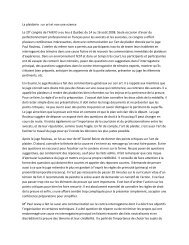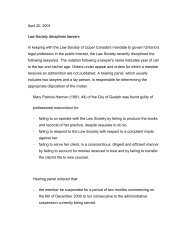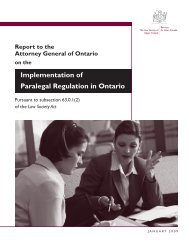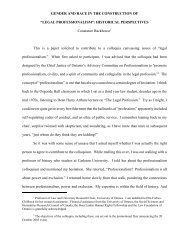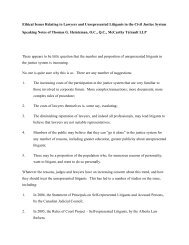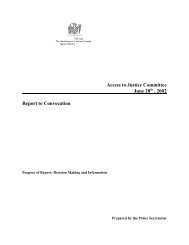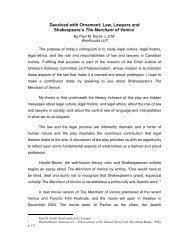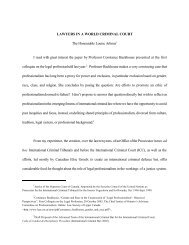of self regulation? - The Law Society of Upper Canada
of self regulation? - The Law Society of Upper Canada
of self regulation? - The Law Society of Upper Canada
Create successful ePaper yourself
Turn your PDF publications into a flip-book with our unique Google optimized e-Paper software.
pr<strong>of</strong>ession in order to both protect the public and promote its reputation “funnels in”<br />
conduct that would otherwise go unchecked. 115<br />
9. Commitment to the Public Good<br />
This is essentially a psychological argument—because lawyers recognize that<br />
they have been entrusted with a sacred privilege they tend, both as individuals and a<br />
group, to contribute to the public good by, for example, seeking to maintain high<br />
standards <strong>of</strong> “pr<strong>of</strong>essional purity” 116 and moral reasoning among themselves. 117 Others<br />
also suggest that <strong>self</strong> <strong>regulation</strong> encourages lawyers to enhance access to justice through<br />
reduced fees for those who are in need, or even participation in pro bono activities. To<br />
remove <strong>self</strong> <strong>regulation</strong> would be to undercut this psychological motivation to promote the<br />
public good, and alienate the pr<strong>of</strong>ession from its traditional commitments. 118<br />
B. Arguments Against<br />
<strong>The</strong>re are, however, a significant number <strong>of</strong> arguments that cast doubt on the<br />
foregoing claims. <strong>The</strong> essence <strong>of</strong> the critique is that <strong>self</strong> <strong>regulation</strong> is a privilege (not a<br />
right) that was granted to the legal pr<strong>of</strong>ession as part <strong>of</strong> a “regulative bargain” 119 and in<br />
return the pr<strong>of</strong>ession would promote and protect the public interest. 120 <strong>The</strong> legal<br />
pr<strong>of</strong>ession, the critics claim, has failed to live up to the regulative bargain on a number <strong>of</strong><br />
levels.<br />
115 Seneviratne, Legal Pr<strong>of</strong>ession, supra note 2 at 146; Joan Brockman & Colin McEwen, “Self-Regulation<br />
in the Legal Pr<strong>of</strong>ession: Funnel In, Funnel Out, or Funnel Away,” (1990) 5 C.J.L.S. 1; Joan Brockman, “An<br />
Update on Self-Regulation in the Legal Pr<strong>of</strong>ession: Funnel In and Funnel Out” (2004) 19 C.J.L.S. 55.<br />
116 Hurlburt, supra note 2 at 112, 141-144; Seneviratne, Legal Pr<strong>of</strong>ession, supra note 2 at 175.<br />
117 Parker JL, supra note 100 at 134; 151-152; Wilkins, supra note 100 at 863.<br />
118 MacKenzie, Models, supra note 102 at 17, 38.<br />
119 Seneviratne Legal Pr<strong>of</strong>ession, supra note 2 at 8-9.<br />
120 See also, <strong>Law</strong> <strong>Society</strong> <strong>of</strong> New Brunswick v. Ryan, [2003] 1 S.C.R. 247 at para. 36 (per Iacobucci J.).<br />
34



